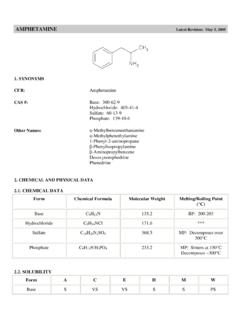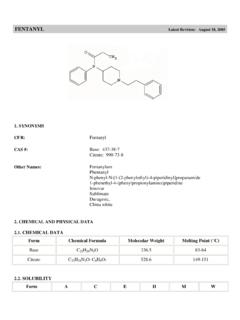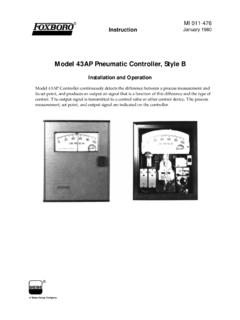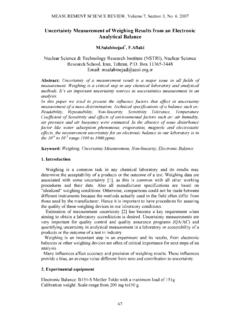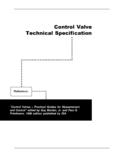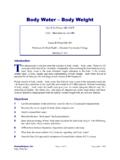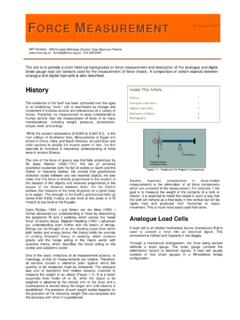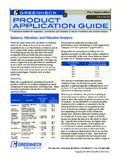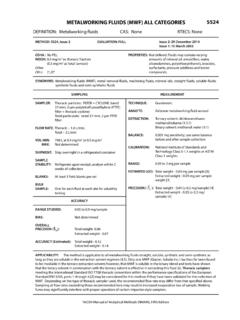Transcription of Measurement Uncertainty for Weight …
1 Measurement Uncertainty for Weight Determinations in Seized Drug Analysis Supplemental Document SD-3 Revision 2 SWGDRUG 2011-07-07 All rights reserved Page 1 of 19 SUPPLEMENTAL DOCUMENT SD-3 FOR PART IVC Quality Assurance/ Uncertainty Measurement Uncertainty for Weight Determinations in Seized Drug Analysis NOTE: Changes have been incorporated throughout Revision 2 to include a Table of Contents, an additional example of Dynamic Weighing and a more thorough discussion of correlation. Table of Contents A Example 1: Dynamic Weighing of a Single Item Using a Budget Factors contributing to Weight Measurement Uncertainty ..4 Uncertainty Budget Table ..5 Notes for the Uncertainty Budget Table ( )..6 Calculation of combined standard Calculation of expanded Uncertainty ..7 Results ..8 B Example 2: Static Weighing of a Single Item Using a Budget Factors contributing to Weight Measurement Uncertainty ..9 Uncertainty Budget Table.
2 9 Calculation of combined standard Calculation of expanded Uncertainty ..10 Results ..10 C Example 3: Static Weighing of a Single Item Using Control Chart Data in a Budget Factors contributing to Weight Measurement Uncertainty ..11 Uncertainty Budget Notes for the Uncertainty Budget Table ( ) ..12 Calculation of combined standard Calculation of expanded Results ..13 D Example 4: Static Weighing of Multiple Items to Obtain a Total Net Factors contributing to Weight Measurement Uncertainty ..14 Uncertainty Budget Calculation of combined standard Calculation of expanded Uncertainty ..15 Results ..15 Measurement Uncertainty for Weight Determinations in Seized Drug Analysis Supplemental Document SD-3 Revision 2 SWGDRUG 2011-07-07 All rights reserved Page 2 of 19 E Books ..16 Journal articles and reviews ..16 On-line resources ..18 Measurement Uncertainty for Weight Determinations in Seized Drug Analysis Supplemental Document SD-3 Revision 2 SWGDRUG 2011-07-07 All rights reserved Page 3 of 19 Introduction The following examples demonstrate the application of an Uncertainty budget approach for Weight determinations and should be used in conjunction with SWGDRUG Recommendations Part IV C, Section 4.
3 These examples are designed to assist laboratories in developing Uncertainty budgets relevant to their procedures and practices. They should not be directly applied to methodology used in laboratories without first considering the specific purpose of a method, its relevant operational environment and the operational capabilities and parameters of the balance . It is assumed that the value being reported is the conventional mass and final results are rounded to the precision of the balance . The calculations shown in the Uncertainty budgets were done using a spreadsheet. In some intermediate calculations, additional digits are shown for illustrative purposes. How the results are reported would depend on laboratory policy. The term Weight is used interchangeably with conventional mass , the quantity typically reported. Definitions for the statistical terms used can be found in the SWGDRUG glossary Part IV C, Annex A or references listed below. The references also contain additional examples and detailed information regarding estimation of Uncertainty .
4 Weighings can be obtained using dynamic or static operations. A dynamic weighing process involves placing a weighing vessel on a balance , taring the balance , and adding material immediately to the weighing vessel without removing it from the balance . A static weighing process involves removal of the tared weighing vessel, filling with material, and then returning to the balance to obtain the net Weight . Examples are included in this document for both scenarios. When the determination of a net Weight requires more than one weighing event, the weighing events may be uncorrelated, correlated, or partially correlated. In practice the correlation, measured as the correlation coefficient (r), is difficult to determine. In the following examples, values of r have not been empirically determined. Rather, values of r have been selected to represent a conservative approach which will likely result in an overestimation of the Measurement Uncertainty . Where applicable, references are provided for laboratories that elect to establish their own correlation values.
5 A Example 1: Dynamic Weighing of a Single Item Using a Budget Table Scenario: A laboratory must determine the Weight of a white powder (approximately 30 g) received in a plastic bag. The bag and its contents are considered to be one item. The decision is made to weigh the material using a two place (readability of ) balance . The following conditions apply: the operator is competent on the use of the balance ; the balance is calibrated and certified as per established laboratory protocols; the balance is being used above the defined minimum balance load; and the balance is performing within the manufacturers specifications. The balance operates in a controlled environment using a draft shield with ambient temperature varying within a range of 5 C. Measurement Uncertainty for Weight Determinations in Seized Drug Analysis Supplemental Document SD-3 Revision 2 SWGDRUG 2011-07-07 All rights reserved Page 4 of 19 The Weight is determined as follows: A weighing vessel is placed on the balance and tared.
6 The analyst immediately transfers the contents of the plastic bag to the tared weighing vessel without removing it from the balance and records the net Weight of the material. The entire operation is considered as a single weighing event (a dynamic weighing). The net Weight obtained for the powder is grams. Factors contributing to Weight Measurement Uncertainty The factors considered in estimating the Measurement Uncertainty include readability; repeatability; linearity; buoyancy; temperature effects; Uncertainty from the balance calibration report; and sample loss in transfer. Although in some cases sample losses could be large, the inability to accurately estimate the Uncertainty due to sample losses is not deemed a major concern since sample losses always result in underestimation of the quantity of a substance being weighed. Therefore, Uncertainty due to sample loss is not included in any of the Uncertainty computations given in this document (SD-3).
7 Buoyancy is difficult to account for in seized drug cases because the density of the material being weighed must be known. However, for material that has a lower density than the steel calibration weights ( g/cm3) the bias imparted is always negative and the Weight displayed by the balance will be less than the true Weight of the material. Ignoring buoyancy contributes a small systematic error that represents no more than bias to the Weight . Therefore, buoyancy corrections are not made in any Uncertainty computations shown in this document (SD-3). Based on the current calibration and performance certification for the balance and given that the balance is operating within specifications, other factors ( environmental, static electricity, corner loading) are deemed insignificant in this example. Laboratories should examine their balances, calibration reports, methods, circumstances, and applications to determine which factors are significant and which are insignificant for their particular application.
8 The factors deemed significant in this example are expressed in the budget table to follow. Uncertainty Budget Table Factors Valuea Distribution Standard Uncertainty (u), g Index (Relative contribution)bReadabilityc,d g Rectangular % Repeatability (s)e g Normal Linearityc,f g Rectangular Temperature coefficientg 6 ppm/ C ( 6x10-6g/g / C)Rectangular -6oo6x10 g/g* 5 C * Uncertainty from balance calibration report (U, coverage factor k=2)h g Normal Subtotal of individual u values:(nu ) Sum of relative contributions: 100% Subtotal of squared u values:( 2nu ) Measurement Uncertainty for Weight Determinations in Seized Drug Analysis Supplemental Document SD-3 Revision 2 SWGDRUG 2011-07-07 All rights reserved Page 5 of 19 Notes for the Uncertainty Budget Table ( ) a. This value could be a standard Uncertainty , the range or half-width of a rectangular distribution, an expanded Uncertainty , or some other quantity reported to express the level of Uncertainty arising from a specified source.
9 The value of all factors should be in the same units. b. 2k2ii=1u*100u This value is used to determine which factors are significant. c. The range of a rectangular distribution is from -a to +a. Therefore, half the value of the full range is used to determine the standard Uncertainty . d. Obtained from the current calibration and performance certification for the balance and assumes that the balance has a single readability range. e. Determined empirically in the laboratory. f. This value is the maximum permitted deviation across the mass range of the balance . g. Value obtained from manufacturer specifications is 5 C. Since the distribution is rectangular, half the range is used (5 C). h. A conservative approach would involve the Measurement of Uncertainty of the balance calibration at the upper working mass range of the balance . Measurement Uncertainty for Weight Determinations in Seized Drug Analysis Supplemental Document SD-3 Revision 2 SWGDRUG 2011-07-07 All rights reserved Page 6 of 19 Calculation of combined standard Uncertainty Considering all factors noted above ( ) as uncorrelated for a single weighing event, the combined standard Uncertainty can be expressed mathematically as: Measurement Uncertainty for Weight Determinations in Seized Drug Analysis Supplemental Document SD-3 Revision 2 SWGDRUG 2011-07-07 All rights reserved Page 7 of 19 222c(single weighing event) = u(read) + u(repeat) + u(linear) + u(balcal)u2where u is the standard Uncertainty and uc is combined standard Uncertainty .
10 The factor u(temperature coefficient) is not included in the combined Uncertainty due to its minimal relative contribution to the total standard Uncertainty . Therefore, the combined standard Uncertainty is: 222c(single weighing event) = u( ) + u( ) + u( ) + u( )u2Uc = Calculation of expanded Uncertainty The expanded Uncertainty is expressed mathematically as: U = k*uc Using a coverage factor k = 2 (confidence level of approximately 95%, assuming the net mass follows a normal distributionI): U = 2* g = g Using a coverage factor k = 3 (confidence level of approximately 99% assuming the net mass follows a normal distribution): U = 3* g = g I The approximate confidence levels given in this document (SD-3) assume that the quantities for which expanded uncertainties are being computed each approximately follow a normal distribution. If this assumption does not hold, the actual confidence level attained for these Uncertainty intervals may be lower or higher than the desired levels of 95% or 99% Measurement Uncertainty for Weight Determinations in Seized Drug Analysis Supplemental Document SD-3 Revision 2 SWGDRUG 2011-07-07 All rights reserved Page 8 of 19 Results Net Weight : g g (k=2) Net Weight : g g (k=3) B Example 2: Static Weighing of a Single Item Using a Budget Table Scenario: The scenario is the same as in Example 1.
